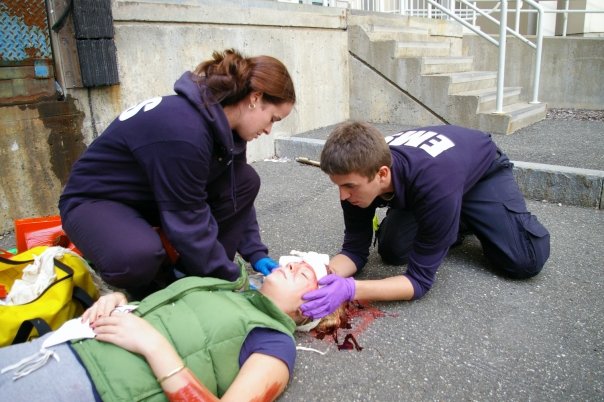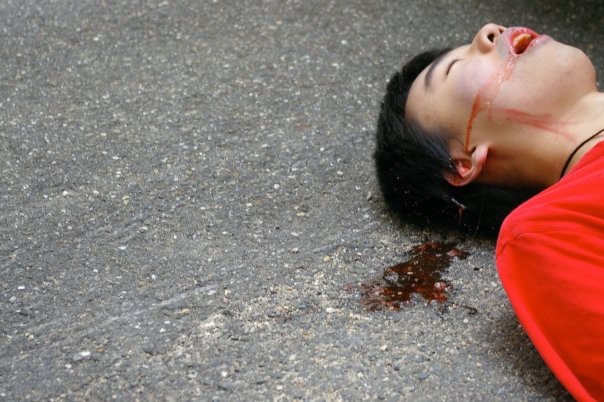|
On the windy and cold Sunday morning of November 16th, EMTs and volunteer patients filed into Draper Hall on the University of Massachusetts, Amherst campus to begin preparations for a full-scale Multi-Casualty Incident Drill, which would be conducted twice during the afternoon.
A rented PVTA bus sat precariously in the parking lot of Lederle Tower, waiting for every “victim”, decorated with fake blood and broken bones, to assemble at the mock accident scene. Around two in the afternoon, the first half of the drill began with a radio call from Executive Director and mock dispatcher, Joe McGrath, notifying the EMTs of a bus accident.
The first half of the drill, involving six patients, took approximately 35 minutes. After a quick pizza break, the second run, involving over ten patients, took an additional 45 minutes. Each half was a whirlwind of triaging, which is the system of prioritizing patients, backboarding, splinting, and bandaging.
“The [drill] times were within acceptable limits,” explains Peter Kaminski, Director of Training at UMass EMS, “We had a good amount of priority ones and priority two patients. Given the amount of patients, I would say it was appropriate and they did a good job.”
Though most of the drill went on without incident, there were aspects that could have been better. “Everything functioned the way it was supposed to, but every organization can always stand to improve,” insists Kaminski, “It would be nice to have even more group involvement and attendance next time. It’s good to know that most of our group is functioning up to par, but it would be nice to know that they all can.”
As for the volunteer patients, Kaminski feels “we had some pretty excellent actors. People knew quite well how to use their voices and take on their roles. They were involved. EMTs Steph Wong and Jane Wieler brought a whole new dimension of realism to the scene as make up artists.”
Tristan Baur, volunteer “victim” and ex Los Angeles paramedic, feels that the drill was a success, but that it would have been more fun if the weather had been more favorable. “I was expecting to play an injured victim in a large scale accident. However, I was not expecting the cold wind,” he recalled, “They worked hard and kept calm in a situation that could have been much worse. I was a bit bummed that I didn’t get a blanket after I was back boarded, though.”
Another improvement that Baur feels could be made if more drills are conducted is, “better communication skills when handing patients off to other medical personnel.”
Kaminski agrees, “I’d like to see people read their resources better,” he explains, “It might have been a good idea to use the buildings in the surrounding area to stage the patients after they’d gotten out of the bus. A little bit more communication and radio protocol, checking in with superior officers more often and such. In the end, though, I think that all of the participants did their jobs exceptionally.”



|


